Cba Nb Meeting: Resource Arrangements With Indigenous Areas: Challenges And Opportunities.
You may have listened to the Act described as Bill C-92 as it was known before its enactment. With more Aboriginal youngsters in treatment now than at the elevation of property schools, this law was an innovative step forward.
Grassy Tightens Passes Ana Land Statement, Insists Sovereignty Over Traditional Area.
- Via the claims process, they currently have title to over 240,000 square kilometers or virtually 50% of the Great site Northern Area's land mass.
- Instead, there is a requirement to accept the Native Title Represent what it is, the long overdue acknowledgment that Aborigines and also Islanders are the previous owners of Australia, which indigenous individuals continue to have standard legal rights and also interests in a big percentage of the continent and also surrounding waters.
- This act enabled Aborigines, who comprise 25% of the Northern Region population, to acquire property title to previous reserve locations.
- The type of title is natural property; it can not be marketed or given away to ensure that Indigenous teams hold title, not simply for themselves, but also for future generations.
- The Northern Region experience showed that programmers have nothing to fear in the long-term by discussing with Aboriginal people.
- Cultural Survival pictures a future that appreciates as well as honors Aboriginal Peoples' fundamental civil liberties as well as dynamic cultures, deeply and also richly intertwined in lands, languages, spiritual traditions, and artistic expression, rooted in self-determination and also self-governance.
The NWT is to be split pursuant to the Nunavut Arrangement of 1993 which will, when implemented, produce 2 new political systems. In the east, Royal prince Edward Island joined Confederation in 1873; Newfoundland did not do the same until 1949.
To deal with the a lot more general trouble, a modification to the Indian Act made it prohibited to raise funds or maintain advice to progress an Indian insurance claim. Railroad business expropriated book lands openly, often on speculation, as well as often split areas down the middle by pressing through the major lines.

What was the basis of Aboriginal law?
Law grounds
Traditionally Aboriginal law was decided in councils of men and they decided matters of the land and its boundaries. These men met on law grounds which were usually within the boundaries of a tribes' country. Some of these law grounds however were on the boundary itself, hence accessible for both tribes.
Altman says that federal governments saw mining as a chance for financial advancement in remote areas paid by the economic sector, not the public bag. Prior to 1976, miners had unrestricted legal rights to gain access to Crown land, yet had to work out with the Crown or the Northern Area management for authorizations to operate Aboriginal books. The mining entrance hall enabled book areas to be exhumed or shut and moved if a significant locate was made.
What is aboriginal law called?
![]()
Indigenous Australian customary law refers to the legal systems and practices uniquely belonging to Indigenous Australians. Indigenous customary lore is intertwined with cultural customs, practices, and stories from the Dreamtime (in the case of Aboriginal Australians).
While there has actually been some improvement in the rates of Aboriginal baby and also kid death, the occurrence of diabetes, mental disorder, heart disease as well as smoking-related cancers cells is enhancing. The pattern of health and wellness downside is echoed across a variety of other social indicators such as work, income, education as well as housing (p. 761). Typically, Aboriginal Australians have considerably lower earnings, higher prices of unemployment, lower academic achievement as well as more overcrowded homes. They are additionally most likely to be sent to prison, struggle with childhood years abuse as well as physical violence and are at higher threat of self-destruction (pp. 4-- 6). This socioeconomic drawback subjects Indigenous Australians to greater levels of undesirable risk variables and adds to the increased experience of side physical violence-- the outcome of historic power imbalances-- continuing adverse stereotypes and also trauma.